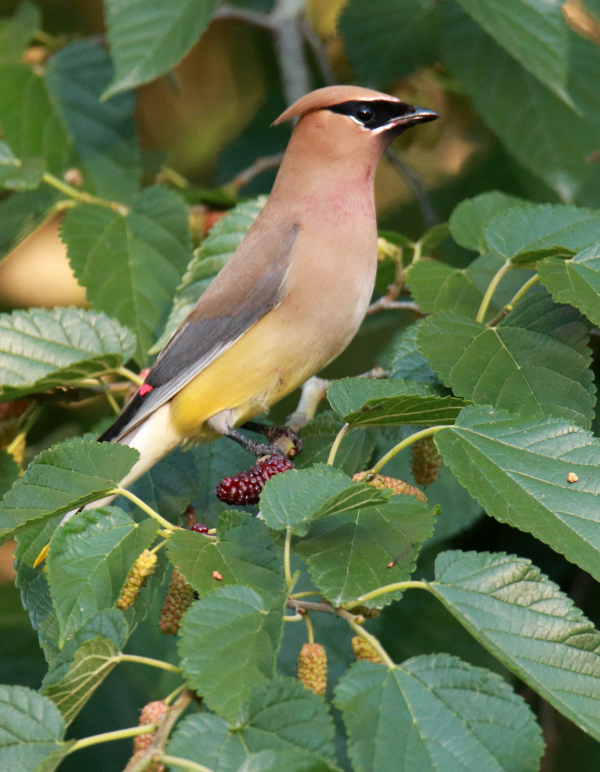
Fruiting trees become magnets for migrating birds and local species as their berries ripen. This Cedar Waxwing is gorging on mulberries.

A variety of plants with open areas and cover at different levels provides an attractive backyard habitat for you and for birds.
|
We wanted to bring Project FeederWatch back into the picture to share some insights provided during a recent essay contest in which participants answered the following query: There are many ways to improve habitat for wildlife. What do you do to make your backyard a haven for birds? With greenhouses and other landscaping outlets stocking up on spring plants, water features, and gardening equipment, an early season landscaping forum provides a nice overview to direct our thoughts toward our own yardscaping.
For the 7th season Project FeederWatch and their sponsor Wild Birds Unlimited are rewarding registered FeederWatchers with the chance to win prizes. In addition, this year Celestron is providing a quality binocular as a prize for each contest winner. After entering their regular bird counts into the FeederWatch website, participants have the opportunity to share a story, memory, or tip by clicking the “Enter to Win” button on the Count Summary webpage. Congratulations to the 2 winners: Pat Brown and Jennifer Gaus-Myers.
Pat Brown shared: Water is our habitat specialty! We live on a lake in north Georgia, have a waterfall and pond water feature, and also place a dish of water near the bird feeding area that more than 30 bird species, 20-plus deer, too many squirrels, and other critters utilize. The outside space where I feed birds is a floor below my big kitchen window, in an area full of deciduous and evergreen trees and shrubs, which includes large trees for birds to hide, rest, roost, and build nests in. There is also brushy areas for the wrens and other birds.
Flower gardening is my passion, which provides more food for birds. Hummingbirds feed on nectar from the perennial flowers, especially the penstemon, pineapple sage, and trumpet vine. Immediately outside my kitchen window is my favorite fig tree where the birds often land before heading to the feeding area. Little did I know when I planted it that it would allow me to take photos of birds from just a few feet away, while offering the benefit of identifying birds that too often are too far away. This bird sanctuary is a gift that puts a smile on my face every day. All the birds and critters appreciate it too!
Planting gardens and landscaping your yard with birds in mind is one of the best ways to help birds as they seek food sources, nesting habitat, protection from predators and inclement weather, resting places, and more. Not only do plants provide food such as seeds, fruit, nectar, and sap, but they also provide habitat for insects, which are essential for many birds and their nestlings. Birds use trees and shrubs for cover and use plant fibers for nesting material. To learn more about how you can improve your yard for birds, take a look at Project FeederWatch’s webpages at Gardening for Birds - FeederWatch
Jennifer Gaus-Myers shared: I have tried to vary my yard’s cover types by using native plants, shrubs, and trees that provide seeds and berries that attract birds. I do not deadhead my flowerheads – I leave the dead stalks standing all winter so birds can access seeds, hidden insects, and perching spots. I have a dust bath area that I keep clear and a heated bird bath with a small bubbler to add sound and keep the water moving. I do not use pesticides; I let all the invertebrates that birds might find tasty have a place in my yard. Many birds nest in my tall spruces and thick hedge. I use UV-reflective products on my windows to reduce window impacts. Additionally, I have 2 wren houses and a Eastern Screech Owl nest box, all on 1/3 of an acre.
Jennifer’s efforts are a great example of what can be done, regardless of the size of yard you have. And yes, providing nest boxes is an important element in a backyard landscaping plan. NestWatch, another resource at the Cornell Lab, has several resources that can help you provide nesting sites for cavity nesting birds. Check out the NestWatch | Features of a Good Birdhouse - NestWatch webpage, and you can also find tips for you to install nest boxes at NestWatch | How do I install a nest box on a pole? - NestWatch
The coming weeks and months will bring a wealth of opportunities to add new plants and plant new seeds, while enjoying our yards along with the birds we benefit in the process. Share your backyard birding experiences and photos with The Birding Wire at editorstbw2@gmail.com